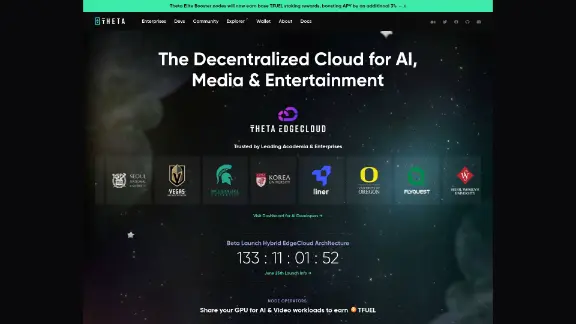Theta Network (THETA)
Theta Network (THETA) is a blockchain-powered system designed for video streaming. It functions as a decentralized network where users share bandwidth and computing resources on a peer-to-peer basis. The network was co-founded by Mitch Liu and Jieyi Long in July 2017.
Overview
Theta Network focuses on media and entertainment, providing infrastructure that enables video and media platforms to enhance revenues and reduce content delivery costs. Users are rewarded for sharing storage or bandwidth on various devices, including PCs, mobiles, Smart TVs, and IoT devices. Theta supports Turing complete smart contracts and is compatible with Ethereum, allowing Web3 applications such as NFTs, decentralized exchanges, and DAOs to be developed on the network.

| Ticker | THETA |
| Category | Smart Contract Platform |
| Website | https://www.thetatoken.org/ |
| @Theta_Network | |
| https://www.reddit.com/r/theta_network/ |
Technology
Theta Network comprises two interconnected subsystems: the Theta Blockchain and the Theta Edge Network.
Theta Blockchain
Consensus mechanism
Theta employs a multi-level BFT consensus design, combining Enterprise Validator Nodes with community-run Guardian Nodes. Validator Nodes propose and finalize new blocks, while Guardian Nodes ensure the blocks' integrity. This design offers security comparable to other PoS chains with an additional layer of security similar to the Gasper consensus protocol.
Smart contract support and EVM compatibility
The Theta blockchain mainnet supports Turing-complete smart contracts, enabling diverse user experiences and applications, such as digitized item ownership and crowdfunding. The Theta Virtual Machine's compatibility with the Ethereum Virtual Machine facilitates the efficient porting of Ethereum-based contracts to Theta.
Theta Metachain
Introduced in April 2022, the Theta Metachain is an interconnected network of blockchains aimed at achieving unlimited transactional throughput and swift block finalization. Comprising a "main chain" and several "subchains," it allows for independent transaction execution and seamless flow of crypto assets across chains. The Metachain was launched on December 2, 2022, with partners creating their subchains, enhancing the network's scalability and functionality.
Dual token design
Theta Token (THETA): Serving as the governance token for the Theta protocol, THETA is used for staking, contributing to block production, and protocol governance. The token supply is fixed at 1 billion. Initially launched in December 2017 as an ERC20 token, it transitioned to the mainnet on March 15, 2019.
Theta Fuel (TFUEL): TFUEL is the operational token for on-chain activities like payments to Edge Node relayers and smart contract interactions. Relayers earn TFUEL for video stream relay, with the supply increasing annually at a fixed percentage.
Theta Edge Network
Theta Video API
Decentralized video-on-demand: Launched in November 2021, the Theta Video API enables developers to add decentralized video to websites or applications easily. Users can relay video over the Theta Network on a peer-to-peer basis.
Decentralized Livestreaming: This feature allows for capturing and relaying live video globally without central servers, utilizing Theta's P2P edge network.
NFT-based Digital Rights Management (DRM): Theta Labs developed a technology for decentralized DRM using NFTs, offering secure management of rights for various applications, including ticketed events.
Theta EdgeStore
- Decentralized data storage: Released in February 2022, Theta EdgeStore is a decentralized key/value storage network, acting as a decentralized content delivery network for various file types.
Collaborations and partnerships
Theta Labs x Sony
In May 2022, Theta Labs partnered with Sony Electronics to introduce NFTs viewable in mixed reality using Sony's Spatial Reality Display, enhancing 3D visualization potential.
Theta Network x World of Women (WoW)
On December 2, 2022, Theta Network partnered with World of Women (WoW) to stream the WoW Gala in Miami, utilizing the ThetaDrop Video Portal powered by Theta Metachain.
Theta x Earworm Media
On January 31, 2023, Theta Network announced a partnership with Earworm Media, utilizing NFTs for comic book content and arcade-style games.
Theta Labs x FedML
On February 16, 2023, Theta Labs partnered with FedML to enable collaborative machine learning for content recommendation and generative AI on the Theta TV platform.
Theta Labs x ABS-CBN
On March 21, 2023, Theta Labs partnered with ABS-CBN to serve as the Web3 video infrastructure partner, building upon the success of "Idol Philippines" on ThetaDrop.
Theta Network x MetaCannes Film3 Festival
On May 2, 2023, Theta Network collaborated with the MetaCannes Film3 Festival, using its NFT-based digital rights management technology to showcase the festival globally.
Theta US Patent for decentralized edge storage network with flexible file sharding
On March 28, 2023, Theta Labs was awarded U.S. Patent 11,611,615 B1, validating its approach to a decentralized Edge Network. This patent complements previously issued patents for decentralized data streaming, micropayments, peer node discovery, decentralized DRM, and preventing denial-of-service attacks. Theta Edge Nodes support decentralized streaming, encoding, transcoding, and storage, providing comprehensive decentralized services for video streaming and file transfer.
